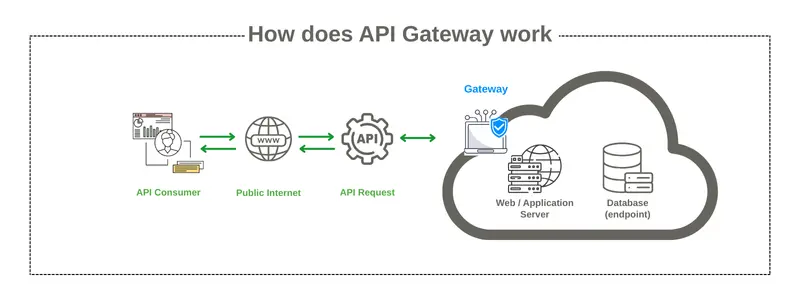API gateways are a set of rules that includes robust protocols to support communication between different networks. Although these rules are well-defined, breaches in their security are not that rare. While there are multiple practices of securing API gateway, implementing all these practices is not an optimal choice as they can hinder your network. In this post, we will tell you about the API gateway and the best practices to keep it secure.
Although it is essential to secure the API gateway, you should implement the practices with caution as the slightest of mistakes can have a severe downside. In case you require professional assistance in securing API gateway, then don’t hesitate to connect with an expert at +1(800) 217-0394.What Exactly Is The API Gateway?
Before we start with securing API gateway practices, let us first tell you about the Application Programming Interface gateway itself, to help clear some doubts. In modern architecture, API gateway serves as a critical component by centralizing entry points between clients and services. Through this, it helps to manage and secure access.
API gateway serves multiple functions, including the one mentioned above. As for its key function, however, is to ensure the security of API and the data it provides. Improving these aspects results in improving the overall workflow. Moreover, it includes robust features, such as authentication and rate-limiting, to further strengthen the security posture of the API.

What Is The Role of API Gateway in Security?
API gateway plays a crucial role in the security of APIs, as it helps to monitor logs and track calls and responses. Moreover, these features also assist in troubleshooting errors and ensuring overall security. In addition to these, API gateway also performs a variety of other functions, such as the ones mentioned below.
- Controls the APIs’ inline point by acting as a proxy.
- Validates all the requests sent to the API.
- Analyzes the traffic to determine the amount of requests reaching the backend of the API.
- Measures the traffic by using features such as throttling and rate-limiting.
- Ensures the safety of the backend services that power APIs.
Also Read : Stuck at Bad Gateway Error Code 502? Here’s How to Fix It
Common Threats Your API Gateway May Face
There are multiple types of attacks that your API gateway may face. Each of these attacks can leave the software more vulnerable and can possibly harm your whole network. Take a look at the most common of the attacks.
DDoS Attacks: DDoS refers to Distributed Denial of Service, and these attacks can overwhelm the API gateway by flooding it with a huge amount of requests and queries. This attack can leave the API gateway unable to respond to any requests.
Data Exposure: In order to gain access to sensitive data, these attacks will exploit vulnerabilities in the API. Data exposure attacks can cause severe downsides such as privacy violations, reputational damage, and data breaches.
Man in the Middle: MitM, also referred to as a Man in the Middle attack, means that the attacker has hijacked the communication between the two parties. Through these attacks, the attacker will be able to manipulate and even steal the data.
While these are the common attacks and can raise chaos in your network, you can avoid them by using practices for securing API gateway.
Best Practices For API Gateway Security
API gateway is a source that connects multiple assets of the network. In case this has been compromised, then a number of critical security problems will arise, one after another. However, you can prevent this scenario from coming to life by adhering to these API gateway security best practices.
1. Make Use of a Centralized Authentication Server
It is a thumb rule to never allow the API gateway to either refresh or access tokens. The reason for using a centralized authentication server is that issuing tokens is a highly complex task and its management also does not come in the easier section.
Multiple entities are required to issue and sign tokens. Even after the token is issued, the API gateway security is not robust. That is why it is the optimal choice to use a centralized authentication server for securing API gateway.
2. Enable Encryption
Among the API gateway security features, enabling encryption is one of the best methods to protect the data transmitted between the client and the API gateway. Through this, you will be able to ensure that there are no gaps for either eavesdropping or tampering.
You can employ protocols such as HTTPS/TLS. This protocol will ensure the confidentiality and the integrity of the data that has been exchanged. As a result of enabling encryption, you will be able to protect all your sensitive information from unauthorized access, thus securing API gateway.
3. Limit Access
In case there are excessive amounts of requests sent to the API, then it is possible for the gateway to be overwhelmed. You may see an overwhelming amount of requests in case of a DDoS attack. Once the number of requests sent reaches the max digit, the gateway will no longer be able to handle them. Although these limits are often redefined in API gateway security policy updates, waiting for these updates to come is not the most ideal choice. Instead, you can use the mentioned below techniques.
Throttling: This can help you to reduce the bandwidth resources or entirely terminate the client session. However, we recommend that you only use this technique when overload occurs.
Size Limiting: This technique can help you to configure the API gateway. By configuring it, you will be able to block the requests if the exceeds the predefined size.
4. Monitor and Audit The Traffic
One of the most reliable methods of securing API gateway is to monitor and analyse the incoming traffic. Doing this will not only help you to learn about the health and performance of the gateway, but you will also be able to check for potential threats. Just by managing and auditing the traffic, you will be able to take the necessary steps, thus securing the API gateway.
5. Keep The API Gateway Updated
Although updates in the API gateway requires you to manually install them, these updates often fixes the security and performance. By keeping your API gateway up to date, you will be able to experience the latest security patches. Moreover, these updates will also help you address the vulnerabilities in your network.
The ones mentioned above are the API gateway security best practices. By implementing these practices, you will be able to ensure the complete safety and security of the API gateway.
Also Read : Here’s All You Need to Know About Rds Error Code 0x3
To Conclude
In order to create a secure API, you must first create a robust API gateway. While there are a multitude of practices for securing API gateway, you don’t need to search the haystack for needles. The practices mentioned in this post are the best ones and will help you to make your API gateway completely safe and secure.
If you have any questions regarding API or need assistance securing it, then connect with our experts at +1(800) 217-0394 for quick and reliable solutions.
Frequently Asked Questions (FAQ)
Does API gateway have a security policy?
Yes, API gateway enforces strong security policies. Moreover, these security policies are updated from time to time.
Can API gateway be deployed on cloud?
Yes, they can be deployed on the cloud. Additionally, API gateway can also be deployed on on-premises and hybrid cloud environments.
How do I ensure API gateway security?
For securing API gateway, you can try by enabling encryption, limiting access, and monitoring the traffic.
Is API gateway a Firewall?
No, API gateway is not a firewall as it does not primarily focus on the network-level security.
How do I protect API gateway from a DDoS attack?
You can protect your API gateway from a DDoS attack by setting rate limiting. This will ensure that API is not overwhelmed by the number of requests.

Brown Lopez is a Cloud Engineer and technical writer based in Austin, USA, who enjoys turning complex cloud ideas into clear, simple insights. With solid experience in cloud architecture and real-world projects, he loves creating practical content that helps professionals understand, build, and improve their cloud solutions with confidence.